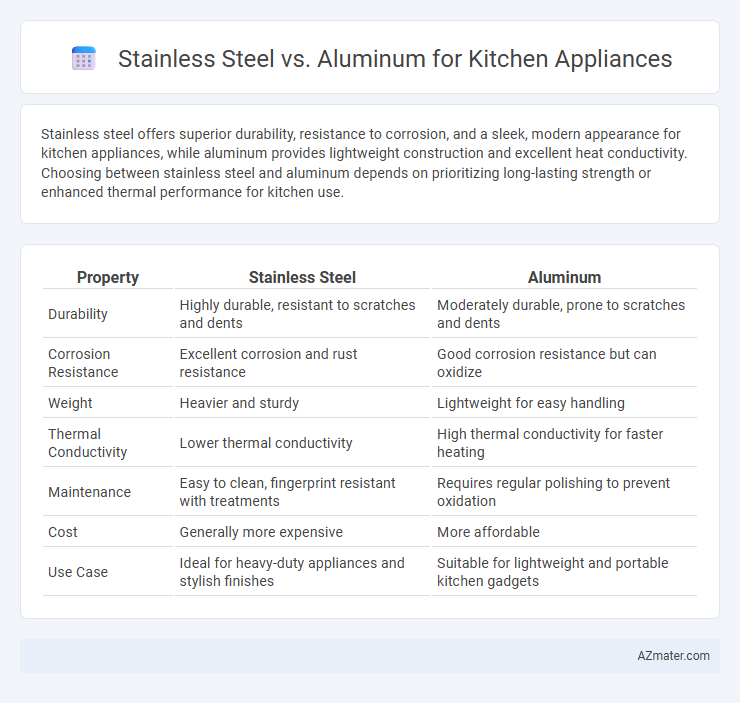Stainless steel offers superior durability, resistance to corrosion, and a sleek, modern appearance for kitchen appliances, while aluminum provides lightweight construction and excellent heat conductivity. Choosing between stainless steel and aluminum depends on prioritizing long-lasting strength or enhanced thermal performance for kitchen use.
Table of Comparison
| Property | Stainless Steel | Aluminum |
|---|---|---|
| Durability | Highly durable, resistant to scratches and dents | Moderately durable, prone to scratches and dents |
| Corrosion Resistance | Excellent corrosion and rust resistance | Good corrosion resistance but can oxidize |
| Weight | Heavier and sturdy | Lightweight for easy handling |
| Thermal Conductivity | Lower thermal conductivity | High thermal conductivity for faster heating |
| Maintenance | Easy to clean, fingerprint resistant with treatments | Requires regular polishing to prevent oxidation |
| Cost | Generally more expensive | More affordable |
| Use Case | Ideal for heavy-duty appliances and stylish finishes | Suitable for lightweight and portable kitchen gadgets |
Introduction: Comparing Stainless Steel and Aluminum in Kitchen Appliances
Stainless steel offers superior durability, corrosion resistance, and a sleek, modern appearance, making it a popular choice for high-end kitchen appliances. Aluminum is lightweight and conducts heat efficiently, which enhances cooking performance but is more prone to scratching and denting. The decision between stainless steel and aluminum depends on factors like appliance longevity, maintenance, and aesthetic preferences in the kitchen environment.
Material Composition and Properties
Stainless steel kitchen appliances are primarily composed of iron, chromium (at least 10.5%), and nickel, which provide superior corrosion resistance, strength, and durability. Aluminum appliances, made from pure aluminum or aluminum alloys, offer lightweight properties and excellent thermal conductivity but are more prone to dents and scratches compared to stainless steel. The choice between stainless steel and aluminum depends on the desired balance of durability, weight, and resistance to corrosion in kitchen environments.
Durability and Lifespan
Stainless steel offers superior durability and corrosion resistance compared to aluminum, making it ideal for kitchen appliances that endure frequent use and exposure to moisture. Its hardness ensures resistance to dents and scratches, contributing to a longer lifespan often exceeding 20 years. Aluminum, while lightweight and corrosion-resistant, is softer and more prone to wear and deformation, resulting in a typically shorter appliance lifespan of around 10 to 15 years.
Weight and Handling
Stainless steel kitchen appliances offer superior durability but tend to be significantly heavier, impacting ease of handling and installation. Aluminum appliances provide a lightweight alternative, making them easier to maneuver and transport, especially in compact kitchens. The choice between stainless steel and aluminum ultimately balances weight considerations with the desired strength and longevity of the appliance.
Corrosion and Rust Resistance
Stainless steel offers superior corrosion and rust resistance compared to aluminum, making it ideal for kitchen appliances exposed to moisture and acidic foods. Its chromium content forms a passive layer that prevents oxidation and ensures long-lasting durability. Aluminum, while lightweight and cost-effective, is more prone to corrosion over time without proper coatings or anodization.
Heat Conductivity and Cooking Performance
Aluminum offers superior heat conductivity at approximately 205 W/m*K compared to stainless steel's 16 W/m*K, enabling faster and more even heat distribution for efficient cooking. Stainless steel, though less conductive, provides greater durability and resistance to corrosion, making it ideal for appliances requiring long-term use and exposure to moisture. Combining aluminum cores with stainless steel exteriors often optimizes heat performance and structural strength in premium kitchen cookware.
Maintenance and Cleaning Requirements
Stainless steel kitchen appliances require minimal maintenance due to their resistance to rust, stains, and corrosion, making them simple to clean with mild soap and water or specialized stainless steel cleaners. Aluminum appliances, while lightweight and good conductors of heat, need more careful cleaning to avoid discoloration and surface damage, often requiring non-abrasive cleaners and immediate drying to prevent oxidation. Regular maintenance for stainless steel ensures a lasting shine and hygienic surface, whereas aluminum demands more frequent attention to maintain its appearance and prevent tarnishing.
Aesthetic Appeal and Design Versatility
Stainless steel offers a sleek, modern aesthetic with a reflective surface that complements contemporary kitchen designs, making it a popular choice for high-end appliances. Aluminum, with its matte finish and lightweight properties, provides greater design versatility, allowing for creative shapes and finishes that suit both modern and traditional kitchens. Both materials resist corrosion, but stainless steel's durability enhances its long-term appeal in maintaining a polished, professional look.
Cost and Affordability
Stainless steel kitchen appliances generally have a higher upfront cost compared to aluminum due to their durability and resistance to corrosion, making them a long-term investment. Aluminum appliances are more affordable initially but may require more frequent replacements or maintenance because they are softer and less resistant to wear. Budget-conscious consumers often choose aluminum for cost savings, while those prioritizing longevity tend to invest in stainless steel despite the higher price.
Environmental Impact and Recyclability
Stainless steel and aluminum are both recyclable materials commonly used in kitchen appliances, but stainless steel has a higher recycling rate, often exceeding 90%, and retains its properties after multiple recycling cycles, reducing environmental impact. Aluminum is lightweight and energy-efficient to transport, with recycling requiring only 5% of the energy needed for primary production, significantly lowering carbon emissions. Both metals contribute to sustainable production, but stainless steel's durability and recyclability offer a longer lifecycle, while aluminum's energy savings during transportation and recycling make it a greener choice in specific applications.

Infographic: Stainless steel vs Aluminum for Kitchen appliance
 azmater.com
azmater.com